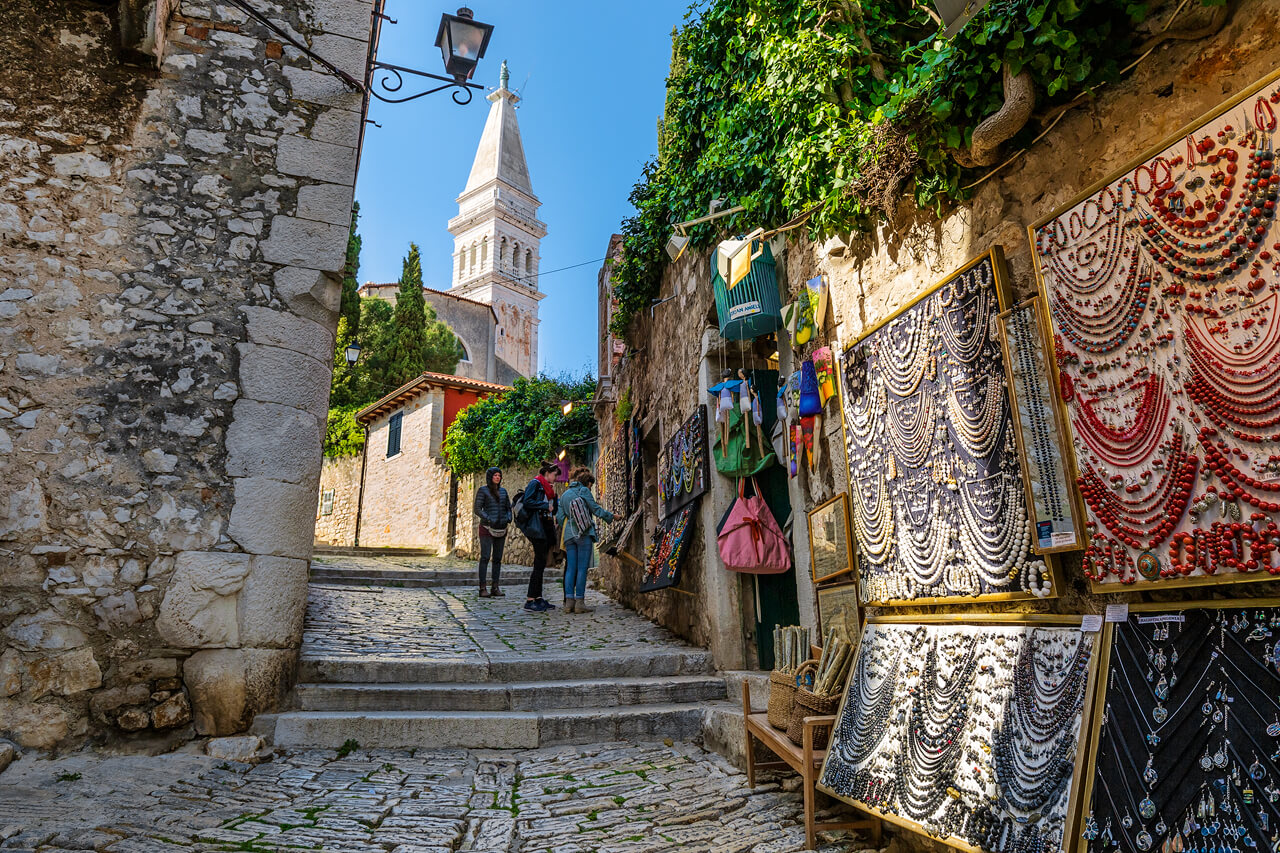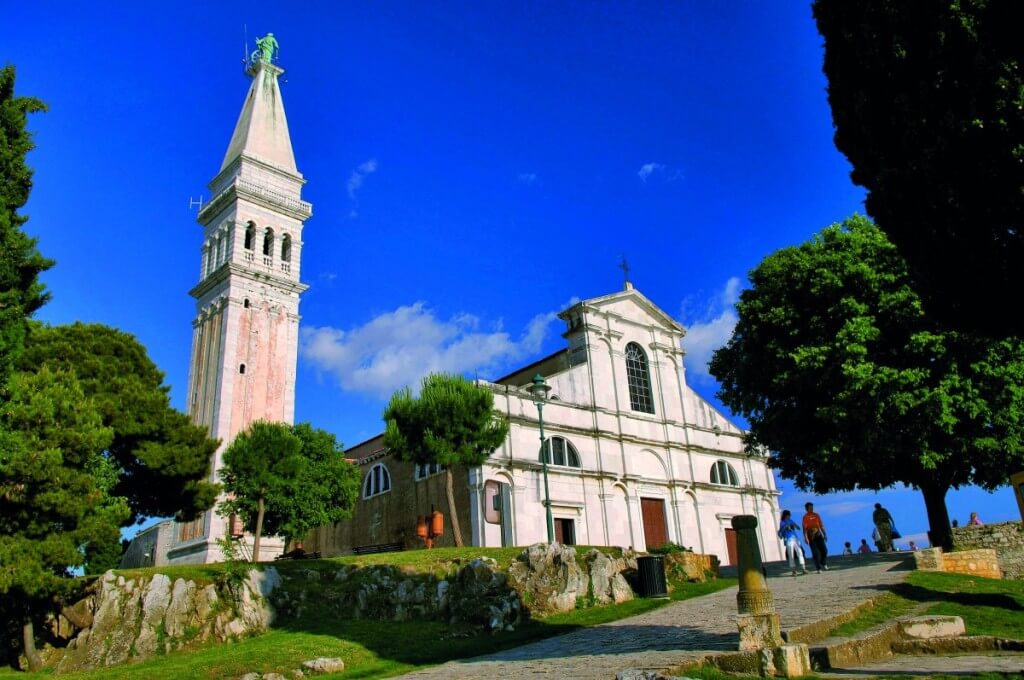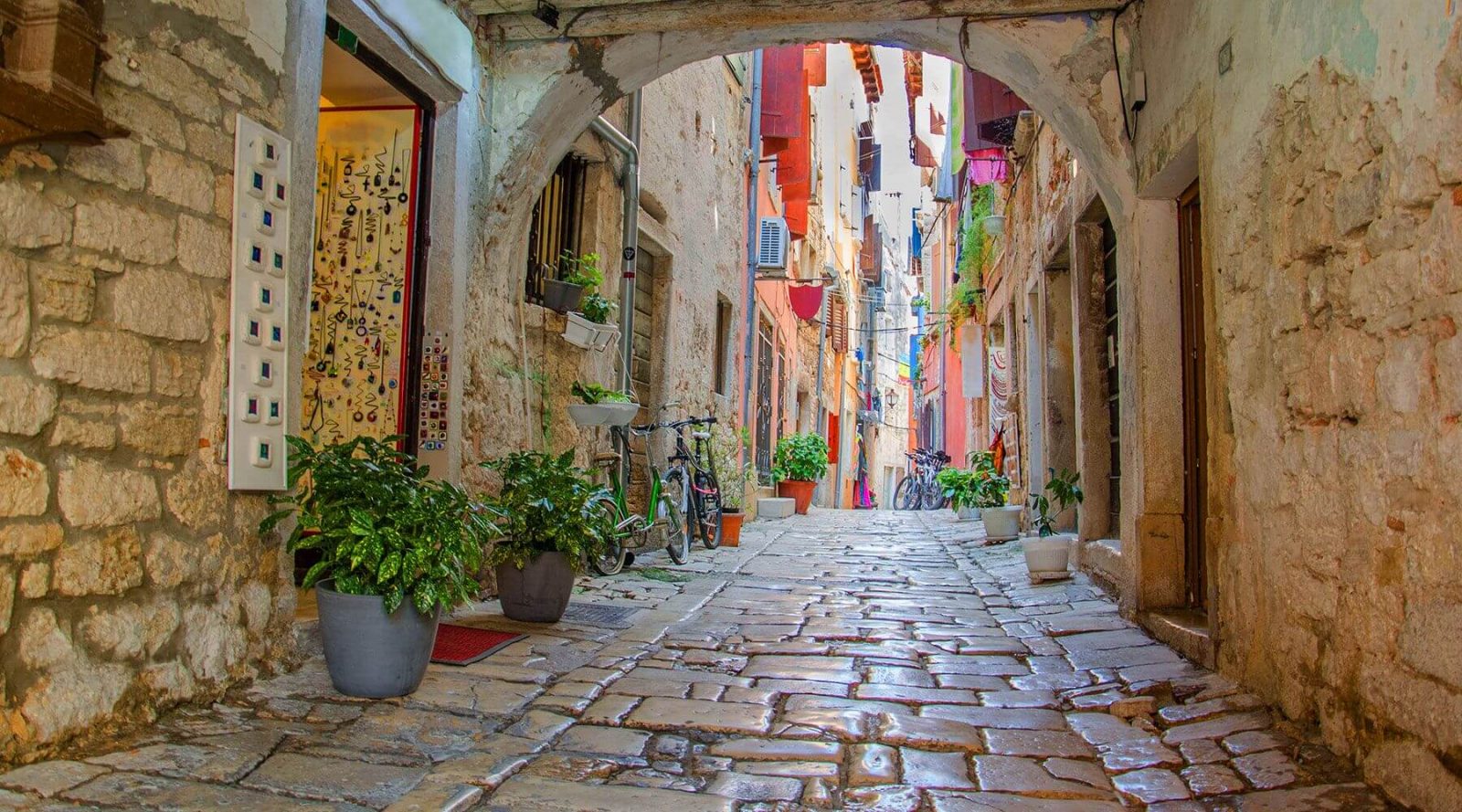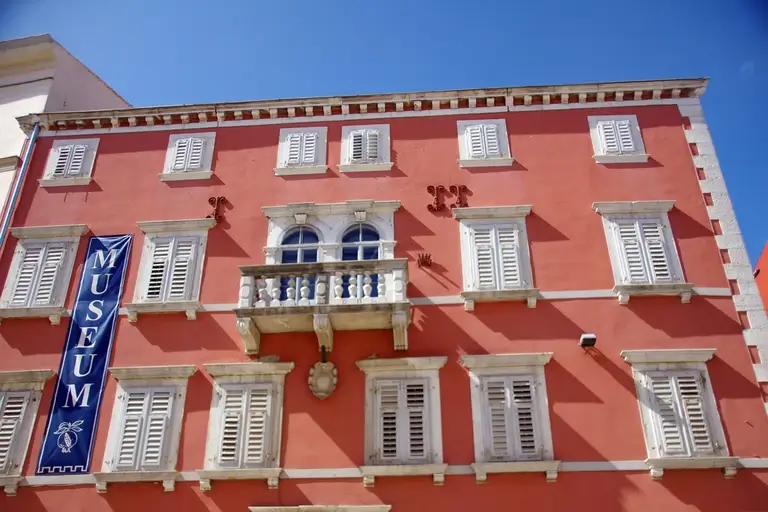Ahogy Rovinj óvárosában találja magát, a dombon magasan álló, ikonikus Szent Eufémia-templom fogadja. Ez a templom a város védőszentjéhez tartozik, és nagy titkot rejt.
A régi történet szerint a követ a Limski Kanal szigetéről hozták a helyiek, ami hihetetlen, tekintve, hogy milyen technológiával rendelkeztek.
Ha tehát még mindig keresi az okot, amiért érdemes Isztriába látogatnia, itt van. Ez a hely tele van csodálatos történetekkel és történelemmel, és persze gyönyörű strandokkal.
Grisia utca felfedezése
A Grisia utca a középkorig nyúlik vissza. Maga a név a latin szürke (grisia) szóból származik, ami tökéletesen leírja, hogy szürke színű kő, amelyet eredetileg évszázadokkal ezelőtt utcák burkolására használtak.
A Grisia utca ma is a kreativitás epicentruma, hiszen a művészek még mindig minden évben özönlenek erre a nyüzsgő utcára, hogy a szűk sikátorok mentén felállítsák a festőállványokat, és megfestsenek a tengerparti panoráma jeleneteit vagy megörökítsék a helyi életet festőállványokkal.
Éppen ezért a Grisia utca egyik legmegragadóbb eleme az évente megrendezett művészeti kiállítás, a Grisia Art Exhibition. Minden nyáron Horvátország minden tájáról érkező művészek gyűlnek itt össze, hogy bemutassák műveiket.
Képzelj el egy szabadtéri galériát, ahol festmények, szobrok és kézműves tárgyak töltenek meg minden felületet – egy olyan esemény, amely összehozza az embereket, miközben a kreativitást és a közösséget ünnepli! Messziről és távolról érkeznek a látogatók, hogy megtapasztalják a művészet erejét ezen a festői helyszínen.
Bár ez a kiállítás talán nem mindenkinek szól, arra bátorítjuk, hogy legalább néhány darabra vessetek egy pillantást. Különösen, ha Rovinjban, a tengerre néző isztriai villáink egyikében száll meg. A Villsy segítségével Horvátországban bármelyik évszakot kihasználhatja, és mi lenne jobb idő Isztria meglátogatására, mint amikor több esemény is van az időben?
Nem csak a művészetkedvelők fogják értékelni a Grisia Streetet, az ételek szerelmesei is tökéletes helyszínnek találják. Végigsétál a szűk sikátorokon, amelyeket gyönyörű és heterogén homlokzatok szegélyeznek, és néhány lépés alatt felfedezi a frissen sült sütemények illatát, amely a helyi kávé aromájával keveredik.
Ehet hagyományos horvát ételeket, például fritule-t, mini fánkszerű, porcukorral megszórt finomságokat, vagy egyszerűen megihat egy pohár helyi bort.

Szent Eufémia barokk pompája
A Szent Eufémia templom egy rendkívüli templom, amely tele van gyönyörű díszítésekkel és díszes részletekkel, a bonyolultan faragott oltároktól a csillogó ólomüveg ablakokig – minden centimétere építészeti gyönyörködtetést jelent a látogatók számára!
Jó eséllyel szemtanúja lehet a templom egyik legértékesebb kincsének – Szent Eufémia maradványait egy díszes aranykoporsóban őrzik, és a hit erőteljes szimbólumaként szolgálnak a hívők és a látogatók számára egyaránt.
A Szent Eufémia templom különösen figyelemre méltó a helyi hagyományokkal és néphagyományokkal való kapcsolata miatt; a templomok számos kultúrában a közösségi élet központjaiként szolgálhatnak; a Szent Eufémia templom e tekintetben kiemelkedik e központok közül.
Ez a templom egész évben különböző ünnepségek és események házigazdája, a vallási fesztiváloktól kezdve a kulturális előadásokig – ez a templom a város életében és kultúrájában hosszú ideje fennálló örökségének tanúbizonysága.

Macskaköves sávokon való navigálás
Rovinj a legszebb isztriai helyek közé tartozik, ahogy macskaköves sikátorai is. Rovinj szeles útjain kanyarogva a kövek, amelyekre lépni fogsz, nem véletlenszerűen és feltűnően formálódnak a földön, hanem gyönyörű mozaikokat alkotnak, amelyekben mindenki gyönyörködhet, aki rájuk lép!
A macskakövek nem csak esztétikusak, de viharos esők idején jól elvezetik az áradó utcákat.
Ne felejtsen el lefelé nézni járás közben! A kopott kövek között talán észreveszel egy egyedi mintát vagy egy apró részletet, amely megragadja a szemed. Vagy beütheti a lábát egy felemelt kőbe, és elesik.

Múzeumok és galériák
Az egyik kihagyhatatlan úti cél a Rovinji Örökség Múzeum, amely lehetővé teszi, hogy visszautazzon az időben, és felfedezze a város lenyűgöző történelmét.
Ha értékeli a művészeti alkotásokat, a rovinji Batana House Museum lehet, hogy pont az, amit keres. Ez a múzeum Rovinj hagyományos hajójának, a batanának állít emléket, és egyben bemutatja annak kapcsolatát a tengeri élettel.
Ne hagyja ki a kortárs művészeti kiállításokat kínáló Adris Galériát. Élénk terében szemtanúja lehet annak, hogyan találkozik a hagyomány a modernitással; ez a galéria emellett gyakran ad otthont közösségépítő eseményeknek, amelyek összehozzák az embereket.

A legjobb étkezőhelyek Rovinj óvárosában
Rovinj óvárosa egy kedves úti cél, amely nemcsak történelmi szépséggel, hanem ízletes kulináris élményekkel is büszkélkedhet.
Ahogy végigsétál a macskaköves utcákon, ízlelőbimbóit máris kényeztetni fogja. Ha Isztrián, vagy különösen a Rovinjban található villákban száll meg, feltétlenül ki kell próbálnia a “Konoba Gianninót", amely az óváros egy furcsa sarkában található. Itt megkóstolhatja a hagyományos isztriai ételeket, amelyeket egy csipetnyi szeretettel és helyi fűszernövényekkel ízesítve főznek.
A “Balbi" a történelem és az ízek tökéletes keverékét kínálja – ez az étterem egy 17. századi palotában található, így a vendégek évszázados falak között élvezhetik a finom ételeket – friss tenger gyümölcseivel kényeztethetik magukat, miközben élvezhetik a nagyszerű hangulatot!